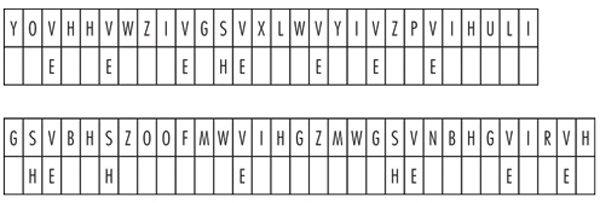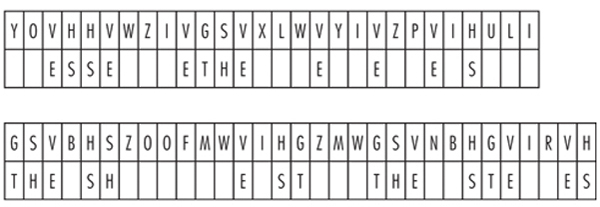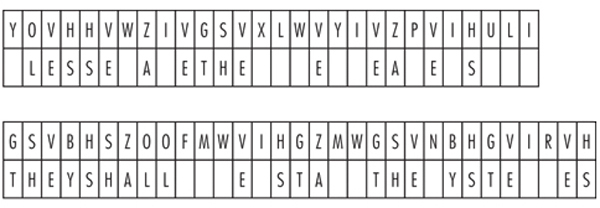30
Nikki pried herself away from Byron half an hour after the show ended. She promised to return in a few minutes so they could head out to the Virginia Beach dance floors.
She found Wellington still toiling away in the booth and slid in next to him. She felt guilty for ignoring him most of the night. “How’s my partner in crime?” she asked.
He was staring at a chart of block letters in front of him. “I think I’ve just about got it figured out.”
“You found the key?” Nikki scooted closer and glanced at Wellington’s writing. It looked like hieroglyphics to her. Neat hieroglyphics, with letters encased in perfectly formed boxes. “Where?”
“I didn’t exactly find the key,” Wellington said. He seemed to be blushing. “But I’m using techniques of cryptanalysis to unscramble the message without the key.”
“Oh,” Nikki said. Cryptawhat? She stared at the letters but didn’t know where to begin. “You gonna show me?”
“Sure.” Wellington actually slid a little away from Nikki, to give himself room to think, apparently. When is the last time a guy did that? He placed the book between them and turned from the page where he had been writing to the first page of the introduction—the page where the random code letters were hidden.
“I think this is a simple monoalphabetic substitution cipher,” he began.
“I see,” Nikki said.
“You know what that is?” Wellington looked surprised.
“Some kind of code?”
Wellington’s face fell, as if Nikki had guessed wrong. “Yes. Well, it’s a particular type of code where one letter is substituted for another.”
No kidding, Sherlock, Nikki wanted to say. Instead, she just put her elbow on the table, chin in hand, and nodded.
“For centuries,” Wellington continued as if he were a university professor, “this type of code was considered unbreakable without a key. But then Muslim cryptologists were the first to realize that frequency analysis could decipher just about any monoalphabetic substitution cipher.”
“Frequency analysis,” Nikki repeated, her elbow sliding farther forward on the table.
“Yes. That’s why I needed to make a call,” Wellington said. “I had my mom check something on the Internet.” He turned back to the title page in the front of the book—a mostly blank page he had been using as his scratch pad. “I had her look up the average frequency results for the letters of the English language.”
Nikki slid up so she could see the chart.
E = 12.7%
T = 9.1%
A = 8.2%
O = 7.5%
I = 7.0%
N = 6.7%
S = 6.3%
H = 6.1%
R = 6.0%
“Now, these are just averages,” Wellington continued, “but they give us a good place to start.”
Who thinks of these things? Nikki wondered.
“The next thing I did was to count the various letters in the encoded message and see which ones occurred most frequently.” Wellington flipped back to the first page of the introduction and ran his finger along the code.
“You counted every letter in there?” Nikki asked in amazement.
“That’s just the start,” Wellington said, flipping back to the title page. “Here’s what I found.” He pointed to a place where he had carefully recorded his results. “I started by focusing on the top three letters. V occurred twelve times; H occurred seven; and I occurred six.”
“I’ll take your word for it,” Nikki said, sounding unimpressed. But she actually thought it was clever.
“So if everything followed the law of averages exactly, which it never does, then V would be the substitution for E; H would be the substitution for T; and I would be the substitution for A. Do you follow me?” Wellington astounded Nikki with how much he was into this stuff, coming out of his shell when he talked about code breaking.
“You sure you haven’t been drinking?” Nikki mumbled.
“No. I haven’t.”
“I was just kidding, Wellington. I follow you.”
“Good. Next, I decided to test my assumption about V being the code text for the letter E. I did this by performing a before-and-after analysis. This is based on the well-known fact that vowels like E can be found adjacent to just about any letter of the alphabet, but consonants like the letter T—the second most frequent letter in the English language—tend to avoid certain other letters. For example, how many words do you know where T is next to the letters B or D or G or J or K or M or Q or V?”
Nikki let her head slump a little lower. “None. But then it’s not something I spend a lot of time thinking about.”
“Hey, Nikki, great party.” A few guys stopped by the booth and Nikki perked up. She noticed Wellington discreetly close the book and slide it under his forearm. She talked to the intruders for a few minutes and then they left. She thought about Byron and the Virginia Beach bands in full swing.
Wellington reopened the book, and Nikki returned her chin to her hand.
“So anyway, I found that the letter V acted like a vowel,” Wellington said. “It was next to a lot of other letters—thirteen to be exact. Pretty good confirmation that V probably does represent E, just like we thought.”
One letter down, twenty-five to go. Nikki made a conspicuous show of checking her watch.
“And it gets better. If V is truly E, then it usually doesn’t take long to figure out which letter represents the letter H. Do you know why?”
“Look, Wellington, to be honest, I don’t have the foggiest idea. This stuff is all fascinating, but it would probably go quicker if you just explained it rather than asking me questions.”
Wellington looked deflated, and Nikki immediately felt like a jerk. “Don’t take it personally,” Nikki continued. “You’re doing great. It’s just that I’m more of a lecture-at-me student than a question-and-answer student.”
“Okay.” He took a sip of soda. “No problem. Anyway, the answer is found in this quirky little personality trait of the letter H—it almost always comes before the letter E but never behind the letter E. Can you think of a word where H comes behind E . . . Oops, sorry. Like I was saying, there are very few words where that happens.”
“Exactly,” Nikki said, sensing the kid’s need for encouragement. She glanced over her shoulder. Byron was still where she had left him, but it looked like another woman had elbowed into his group.
“Here are the results of my before-and-after analysis,” Wellington said, pointing to another chart on the front page. “The one letter that occurred before V three times but never occurred after V is the letter S. So I was thinking that S in the code letters probably represents H in real life, or what we call plaintext. And I also noticed that S appears in this coded message four times, which would also be consistent with S representing H, because H is a frequently used letter.” Wellington paused and looked pleased. “That’s where I was when you sat down.”
Nikki looked down at his chart.

That’s it? she wanted to ask. All that for two lousy letters?
But Wellington slid forward on his seat, and Nikki had to admit that his enthusiasm was contagious. She took her chin out of her hand and sat up straighter. Was it possible they could solve this entire hodgepodge of letters without a key?
“What do you notice?” Wellington asked, forgetting the rule about questions.
“Can we buy another vowel?” Nikki asked.
“Don’t need to,” the young genius said. “We just need to look for repeating patterns. What is the most common three-letter word in the English language?”
“Sex?”
Wellington turned red, which Nikki thought served him right for asking another question. “Actually, it’s the. And if you look at our chart, you’ll see that the code letters G-S-V repeat themselves three times. Because we already think that S is a symbol for H and V is a symbol for E, it would make sense that G would be a symbol for T, thus spelling the word the several times.”
“Plus,” Nikki said, looking at one of Wellington’s charts, “G is one of our frequently occurring letters in the code message. You would expect it to be if it stood for the letter T, which is the second most popular letter in the English language.” Nikki smiled at herself. Not quite Mensa material, but she had her moments.
“You’re a natural,” Wellington said. He handed his pencil to Nikki to fill in the chart with their new discovery. She did so, resisting the urge to ask him why he was carrying a pencil around with him in the first place.
“Now we look for pairs where the same letter is repeated,” he said.
“I see two,” Nikki said. “What does that tell us?”
“Since we don’t have spaces between the words, it’s a little hard to tell. It could just be coincidence—one word ending in the same letter that the next word starts with. But more likely, it’s one of the letters in the English language that we sometimes see as a pair—S-S, E-E, T-T, L-L, M-M, or O-O. So let’s take an educated guess at what plaintext the code letters HH stand for.”
Wellington pointed to the appropriate spot on his diagram. “We know it can’t be either E-E or T-T because those letters are already taken. And since the code letters H-H are surrounded with a code letter that represents E on one side and another E on the other side, we know they can’t stand for O-O either. I can’t think of any words that have the sequence of letters E-O-O-E. So that pretty much leaves L-L or M-M or S-S. And since the letter H occurs seven times in the code letters, it must be a popular letter.”
Nikki nodded, pencil in hand.
“Let’s therefore assume that H represents S,” Wellington said.
The chart was getting better:

“Now, focus on parts of the chart where we have a lot of letters filled in,” Wellington instructed. “Like right here.” He pointed out a section that had drawn Nikki’s eye as well. “Take a guess at the missing letters.”

Nikki stared for a minute, feeling like a contestant on Wheel of Fortune. “Do you know?” she asked Wellington.
“I think so.”
“Don’t tell me.”
Another minute passed . . . “I’ve got it!” She picked up the pencil and wrote in the letters.

“Now fill in those same letters on the rest of the chart,” Wellington instructed.
When Nikki did so, she realized they were almost there.

She was so enthralled with the chart that she hadn’t noticed Byron standing beside the booth. “Must be a fascinating read,” he said.
Wellington abruptly closed the book as if it were a Playboy magazine and Byron were his mother. Can we call any more attention to it? Nikki wondered.
“You know me and books,” she said.
“How much longer do you think you’ll be?” Byron asked.
This is, Nikki thought, what some would call a moment of truth. She and Wellington were so close to solving this code. Afterward, they would need to check the Internet to see whether Finney had left a message. Her boss might be in some kind of trouble.
But then again, he sure didn’t look like he was in any trouble at the end of the night’s show. And if he were here, Finney would probably just tell Nikki to go out and have a good time.
She ultimately decided to do what Nikki Moreno always did—have it both ways. She turned and faced Byron. First, she had to establish that she didn’t like competition.
“I’ve got to finish tutoring Wellington here, and he’s got a big test tomorrow.” She didn’t dare check behind her to see how badly Wellington’s face was giving away the lie. “Looks like you’ve got someone else over there waiting for you anyway.”
“Kaitlin?” Byron said, looking genuinely surprised. “Not exactly my type, Nikki. If you don’t come, I won’t be able to ditch her all night.”
Next came Nikki’s quick but effective deep-in-thought look. “Tell you what,” she said. “Why don’t you guys go on ahead to someplace at the beach and let me finish up a few things with Wellington. I’ll call you in about an hour, and we can rendezvous at a different bar, away from the gang over there, including Kaitlin.”
Byron gave her a sly I-catch-your-drift nod. “Sounds great,” he said. “You need my number?”
Nikki plugged his number into her cell phone and watched him walk back to his table. “That,” she said more to herself than to Wellington, “is how you solve a real code.”
She turned back to her instructor—or her pupil or whatever Wellington was. “Where were we?” she asked.
He already had the book open to his chart. “What do you think this first word is?” he asked.
“I see it now,” she said. “Y must be B because that first word is blessed. Which also means that W must represent D.”
Wellington filled in the blanks below Y and W and then another match occurred to Nikki. “Z must be the letter A because it’s going to say ‘Blessed are the . . . something.” And so it went, Nikki filling in blanks as Wellington watched like a proud seventeen-year-old father.
Eventually Nikki filled in the last letter and leaned back to read her creation: Blessed are the code breakers, for they shall understand the mysteries.
She held her hand up for Wellington, who managed a clumsy high five.
“It’s a centuries-old cipher,” he explained, his demeanor all businesslike again. “You just reverse the alphabet. A stands for Z and vice versa. Even Old Testament scribes used it occasionally.”
“Oh yeah,” Nikki said. “The atbash cipher.”
She thought the poor boy’s jaw would drop on the table.